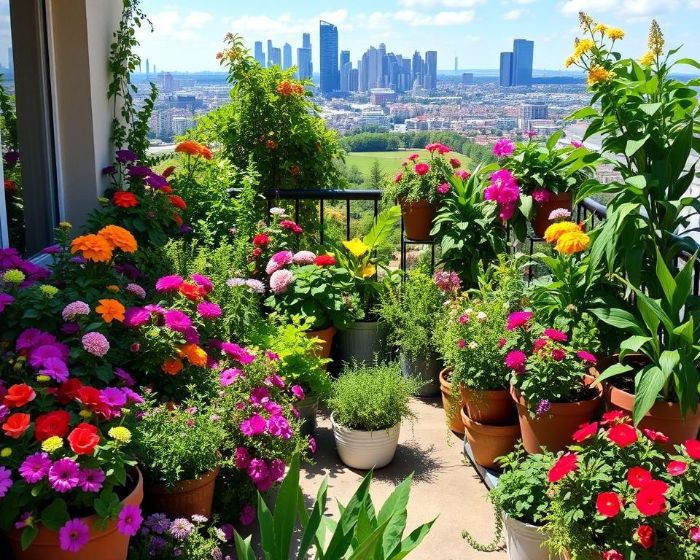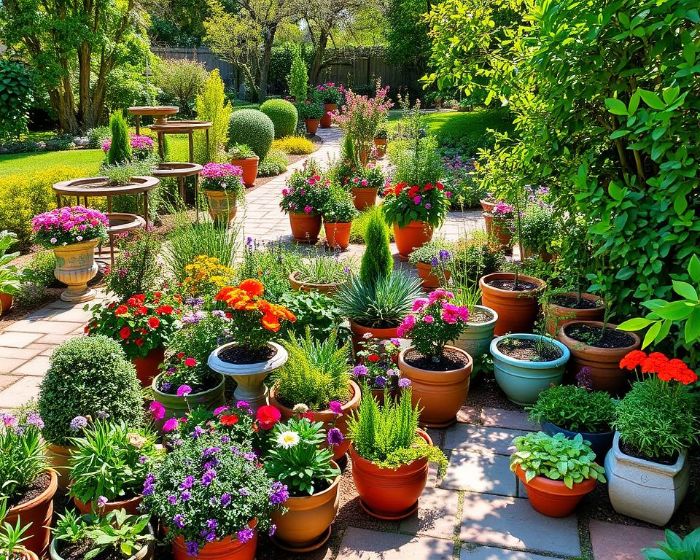Updated October 20, 2025
Container gardening tips pay off when space works like a system.
The stakes are real – leaf edges crisp near bright walls, soil turns slick and sheds water, neighbors complain about drips.
Win back control with placements that calm heat, containers sized to root habits, and watering that runs on a simple timer window.
Watch for quick signals you can spot at a glance, like rocking planters after a gust or glossy mix that refuses to absorb. Pick compact cultivars, keep paths clear for easy tend, and use one vertical frame to multiply growing area without crowding.
The reward is a patio or balcony that grows well, looks tidy, and keeps maintenance short.
Key Takeaways
- Map sun by snapshots at set moments each day
- Choose depth by root habit for calmer watering
- Use one vertical frame to expand capacity neatly
- Schedule a dawn sweep to fix small issues early
- Avoid rock layers that trap water and stress roots
Table of Contents
Choose the spot – light, wind, and load limits
Small spaces grow well when placement is deliberate. For balcony gardening, start with light windows, then judge wind and weight before the first pot moves.
Where to put a container garden?
Place containers where plants receive consistent daylight and shelter from harsh gusts. Track sun by hours of direct exposure. About 5-7 hours suits fruiting crops, while 3-4 hours supports most herbs and leafy greens.
Check shadows cast by railings and nearby buildings at three points in the day – mid-morning, early afternoon, late afternoon. Glare from glass or pale walls can scorch tender leaves; if leaf edges crisp at midday, slide pots 12-18 inches back from reflective surfaces.
Pro tip – log sun with phone photos taken from one position at set times so you can compare week to week.

Read the wind by floor height
Higher floors funnel gusts along corridors and around corners.
Do a quick flag test – hang a light ribbon at rail height for two days. If it streams sideways for more than 15 minutes at a time, choose a leeward corner or a spot tight to a solid wall.
Gusts above roughly 20-25 mph rock tall planters and dry mixes faster than you expect. Leaves that shred along the margins signal abrasive wind, while long, weak stems signal constant sway. If either shows up, shift the layout inward; hardware fixes belong with the layout phase.
Weight and rules
Balconies carry load by square foot. Spread mass, keep the heaviest planters near the building wall, and avoid stacking weight along the rail. Use wide trays that catch spills without overfilling them; neighbors below should see zero drips.
Before you buy soil or large pots, check lease or HOA notes for planter limits, railing clearances, and any ban on overhanging boxes.
As a maintenance habit, lift large containers a finger’s width once a month to confirm they have not bonded to the surface; stuck pots trap moisture underneath and stain decks.
Placement mini-checklist – confirm sun hours; pick leeward corner; keep heavy pots near the wall; leave safe clearance from the rail; set trays that do not overflow; verify building rules.
Good placement removes half of future headaches. When light, wind, and load are handled up front, the remaining work becomes routine rather than rescue.
Space-smart layouts and hardware for patio gardening
Tight footprints reward tidy geometry. Use shapes that hug edges, stabilizers that keep pots upright, and vertical frames that carry foliage without casting heavy shade.
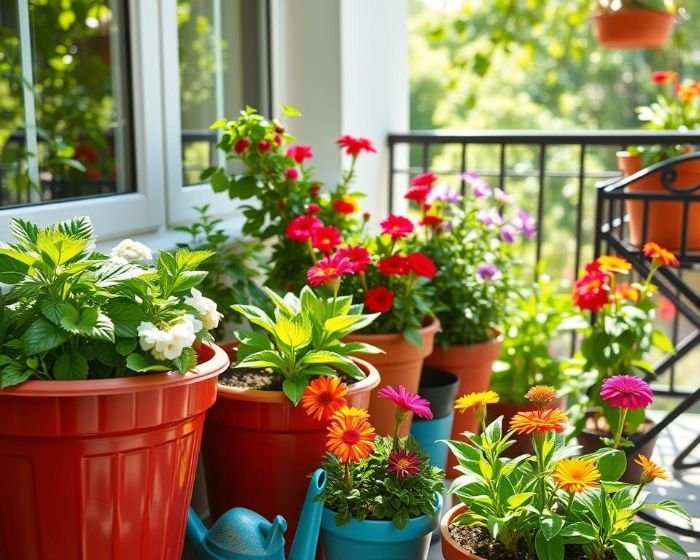
Shapes that tuck in tight areas
Containers shape the flow on small slabs.
Tall cylinders park in dead corners while keeping foliage above foot traffic.
Rectangles run flush against walls and rail lines, turning wasted margins into growing lanes.
Nests and tiers work when each upper rim sits at least 4-6 inches behind the one below so leaves do not shadow the lower tier.
Keep a clear walking strip 16-20 inches wide; cramped paths lead to broken stems and skipped maintenance.
Pro tip – Where doors swing out, mark the arc on the floor and keep container rims 2 inches outside that line.
Stabilize and secure
Stability comes from base width, mass placement, and discreet tie points. Aim for a base-to-height ratio near 1:3 or wider; anything taller benefits from a weighted foot or a low shelf that increases footprint without blocking airflow.
Straps or discreet cords anchor tall planters to fixed posts; pad contact points to avoid abrasion. Railing boxes need internal spreader bars or brackets rated for exterior use, and they should sit inside the rail, not overhanging.
If a pot rocks when nudged half an inch, add an anti-tip plate or relocate it to a sheltered corner before adding more foliage. I recheck anchor points each month and after the first storm of a new season.
Vertical frames with airflow
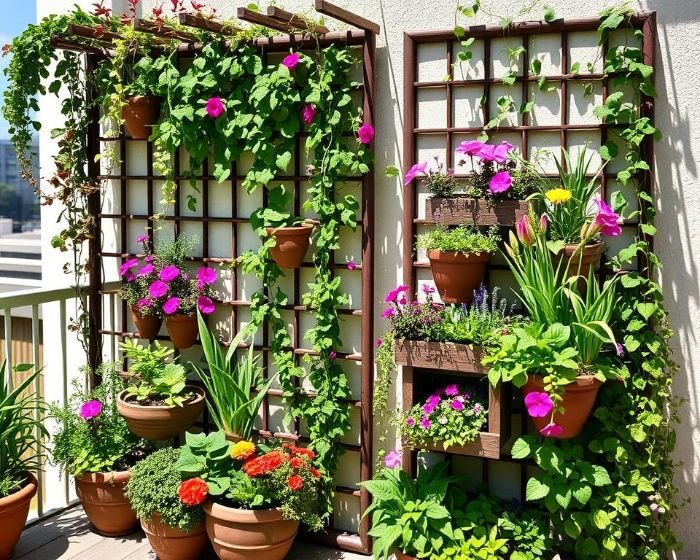
Vertical gear pays off when foliage gets light and air.
Position trellises 1-2 inches off the wall on spacers so leaves dry after watering.
Angle ladder frames 10-15 degrees from vertical to keep centers open; overly flat frames trap humidity and invite mildew. Train vines in a loose zigzag using ties every 8-12 inches so stems flex without cutting into tissue.
When using wall pockets, fill only two-thirds of positions on the shadiest side to avoid a solid green curtain.
Pro tip – if leaves feel clammy at dusk, slide the frame forward by a hand’s width and prune one interior runner to reopen the chimney.
Designing the footprint up front prevents midseason reshuffles. Once shapes, anchors, and frames are tuned to the space, daily care stays quick and plants stand firm.
Right volume, mix, and drainage for steady roots
Roots perform when containers match their depth class and when water exits cleanly. For planters with drainage, size the vessel first, then build a lightweight mix that breathes and holds steady moisture without going soggy.
Rule of thumb for depth and volume
Pick container depth by root class, not by plant height. Shallow-rooted herbs and compact flowers live happily in modest depths, while fruiting crops and root vegetables need more depth and mass to buffer heat and watering gaps. If you split time between home and work, lean one step larger to slow dry-down during hot spells.
Pro tip – when in doubt between two sizes, choose the deeper pot if the footprint is the same.
| Root class | Min depth | Typical volume | Growth habit example |
|---|---|---|---|
| Shallow – herbs/annual color | 4-5 in | 1-2 gal | Parsley, violas |
| Medium – leafy/bushy veg | 10-12 in | 3-5 gal | Lettuce heads, peppers |
| Deep – fruiting/roots | 12-16 in | 7-10 gal | Tomatoes, carrots in tall forms |
| Woody – dwarf shrubs | 16-20 in | 12-15 gal | Blueberries, rosemary standards |
Deeper containers stabilize temperatures on balconies and patios, which reduces midday wilt and keeps feeding schedules predictable.
Do container gardens need drainage?
Yes. Containers need clear exit paths so roots get oxygen between waterings. Aim for several holes totaling roughly a thumb’s width across the base of small pots and more for larger tubs; individual holes can run 3-8 mm.
Elevate pots 0.25-0.5 in on feet so water clears the base instead of pooling underneath. Skip rock layers at the bottom, which create a perched water table that stalls roots near the interface. A fine mesh or coffee filter over holes stops mix loss without slowing the outflow.
Pro tip – if water sits on the surface for more than 10 seconds after a normal pour, open an extra hole or repot to correct compaction.
Lightweight potting recipe and refresh cadence
Use a blend that balances air with moisture retention. A reliable base combines peat-free fiber such as coco with coarse perlite or pumice and a small fraction of mature compost for biology. Bark fines add structure that resists collapse through the season.
For a fast start, charge the mix with a mild, slow nutrient source and then top-dress lightly every 5-7 weeks. I fluff the top inch with a chopstick before top-dressing to reopen pores and prevent crusting after summer showers. If roots circle the inner wall and watering goes uneven, upsize the container at the next refresh rather than forcing extra irrigation.
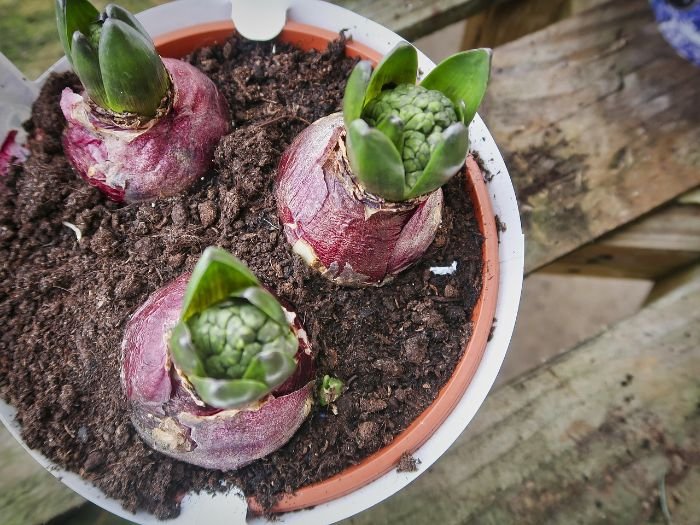
Sizing, drainage, and mix work as a set. When those three align, roots stay active, feeding stays simple, and containers on small patios remain predictable through heat and wind shifts.
Water cleanly and on time in tight spaces
Consistent moisture keeps containers steady on balconies and patios. Set a simple cadence, keep surfaces dry for neighbors, and let hardware carry the load when days run hot.
A routine you can keep
Water early, when surfaces are cool and wind is low. In mild stretches, expect every 2-3 days for leafy pots and closer to daily for thirsty fruiting crops during 85-95°F spells. Use two cues: color shift on the mix from dark to lighter brown and a noticeable drop in pot weight compared with right after watering.
If water beads on top, the mix went hydrophobic; break the crust with a chopstick and water in two light passes a few minutes apart. Keep rims 0.5-1 inch below the top so fills do not spill. Empty saucers within 15 minutes to avoid soggy roots and deck stains.
Pro tip – during heat waves, group containers shoulder to shoulder to slow evaporation without changing the schedule.
Hands-off watering that fits small patios
Automation prevents midweek misses. Self watering planters cover herbs and compact flowers well; check reservoirs once a week and refill before the float bottoms out. For mixed tubs, a simple drip line with 0.5 gph emitters works: one emitter for 10-12 inch pots, two for 14-18 inch planters.
Start at 12-18 minutes per run and adjust by 2-3 minute steps until foliage holds shape through the warmest hour. Place the timer at the wall side to keep hoses tidy and out of footpaths. I open the system for a minute after installation to flush fines before the first real run.
Light feeding without salt build-up
Small volumes prefer gentle nutrition spread over time. Use quarter-strength liquid feed every 10-14 days in the growing push, then stretch to every 3-4 weeks as nights cool. Once a month, water heavily with plain water to wash salts through the profile. White crust on the rim or speckling on leaf edges means salts are accumulating; scrape the rim, leach with an extra long watering, and resume at a lighter rate.
Pro tip – rotate liquid feed with a light top-dress of slow nutrients midseason to stabilize growth without spiking.
Quick routine – water at sunrise; watch mix color and pot weight; empty saucers in 15 minutes; set drip to 12-18 minutes and adjust by small steps; feed at quarter-strength every 10-14 days; leach monthly with plain water.
Watering that respects timing and mess control keeps balconies friendly and plants sturdy. Once the cadence matches the site, most corrections shrink to small tweaks.
Microclimates and quick fixes for balconies and patios
Small sites run on micro-adjustments. Among container gardening tips that actually save plants, fast tweaks to heat, cold, and stress signals carry the most weight.
Heat and glare control
Heat builds fastest on dark surfaces and near reflective walls. When leaf temps climb past roughly 100-105°F at midday, move planters one forearm length away from the hot face or add a temporary shade cloth rated around 30-40% density. Aim the cloth so it blocks the noon angle but leaves mornings open.

Pale trays or slipcovers drop root-zone heat a few degrees; swap dark sleeves during the warm stretch.
If foliage feels tacky at dusk, open the canopy – remove one interior runner and pull the container forward by a hand’s width to restore air movement.
Pro tip – a cheap infrared thermometer confirms hot spots in seconds and keeps adjustments objective.
Cold snaps and easy overwinter moves
Warm-season crops sulk when nights slide under 45-48°F. Before the first cool spell, park a rolling caddy within arm’s reach of your most tender planters.
On forecasted dips, pull pots against a masonry wall to borrow stored daytime heat, wrap the container with a breathable insulating jacket, and lift the base on feet to keep cold puddles from wicking up.
Water lightly a few hours ahead of the front to buffer swings, then skip feeding until nights rebound. For true overwinter candidates, plan a sheltered corner with morning sun and trim soft growth by a third so the plant carries less strain through the lull.
Fast troubleshooting
Read the symptom and act within the same day.
Midday droop that stands up by evening points to heat load. Add temporary shade and widen spacing by a palm to cool the pocket.
Morning droop in mild weather flags dry media or bound roots. Water in two light rounds five minutes apart and schedule the next upsize at your coming refresh.
Brown tips with a pale halo suggest reflected glare. Rotate the pot a quarter turn and shift it off the bright wall.
If leaves spot after a humid night, open the frame, prune one crowded stem, and water at first light so surfaces dry quickly.
Pro tip: Set a weekly “microclimate sweep” on the same day each week to catch problems before they snowball.
Small, repeatable moves keep balconies predictable. When heat, chill, and stress cues get checked on a schedule, growth stays steady without heavy gear or constant reshuffling.
Practical Wrap-Up
Run small spaces with an ops mindset.
Set a simple cadence, predefine triggers, and keep decisions tied to numbers you can check in under a minute. A balcony or patio stays productive when routines are boring and moves are small.
Use tight thresholds:
- If leaf surfaces hit 102-104°F at midday, deploy temporary shade and widen spacing by a palm to cool the pocket.
- If forecast gusts exceed 22 mph, shift tall planters one container width inward and confirm tie points.
- If a reservoir drains in under 48 hours outside of a heat wave, add one emitter or upsize the container before roots stall.
- If pot mass drops roughly 15-20% since the last full watering, irrigate at sunrise so surfaces dry by lunch.
Adopt a maintenance cadence that fits real weeks:
- Do a 90-second dawn sweep daily – quick look for droop, scorch, or rocking.
- Block a 10-minute slot midweek for micro-moves and timer tweaks.
Reserve one weekend slot monthly for heavier work – leach salts, refresh top inch, and retension anchors.
For the start of each season, reset targets and retag plants by water demand so container gardening tips stay actionable when weather shifts.
Starter blueprint for tight sites:
- Commit to one sun lane 30-36 inches wide; pick three container sizes that stack visually; install one vertical frame on spacers; set a hose timer with a single daily window; grow compact cultivars with matching root classes so volume and feeding stay predictable.
- Keep a clipboard on the door with dates, run times, and any quick fixes logged in plain language.
FAQ
How can I estimate container weight so my balcony stays within limits?
Add components before you buy: wet mix averages 45-65 lb per cubic foot, a 10-gallon pot often hits 60-85 lb once hydrated, and each gallon of water adds 8.3 lb. Spread mass on pads, cluster heavier planters near the building wall, and keep clear of rail lines. If lease or HOA rules cite limits, build to 70-80% of that number and log total weight per cluster.
What layout fits a 5×10 ft patio without blocking movement?
Run a perimeter lane along two sides, leave a 24-inch walkway, and place one vertical frame on spacers at the far short wall. Use three tall cylinders for vines in the corners, four rectangles as a low border, and one mid-height tub near the wall for herbs. That footprint keeps watering reach under 6 ft and reduces trips across the space, which helps daily patio gardening stay efficient.
How do I stop containers from staining concrete or decking?
Set pots on feet or ribbed grids so air passes underneath, use trays with a textured underside, and lift each container monthly to break any seal. If you see dark halos after rain, clean with a mild brush and raise the pot another quarter inch. Avoid rubber mats that trap moisture for days.
Can I use graywater on containers safely?
Yes, with rules. Only use water from showers or bathroom sinks with biodegradable soap and no bleach or softener salts. Apply within 24 hours, rotate zones so the same pot does not get every cycle, and follow with clear water once every 3-4 uses to prevent residue. Skip edible leaves if products list antiseptics or heavy fragrances.
When do self watering planters struggle in heavy rain?
Problems show when overflow ports sit flush on the ground or get blocked. Elevate planters 0.5-1 inch so overflows drain, confirm the inlet tube cap is seated, and empty the reservoir after multi-day storms to avoid anaerobic odors. If algae films develop, flush with clear water and shade the reservoir window.
What quick method maps sun on a small balcony without tools?
Mark three spots on the floor with tape, then take phone photos from one position every 90 minutes on a clear day. Count hours where each mark sits in direct light. Fruiting crops need the mark with 6-plus hours; leafy greens stay happy at 3-5. Repeat after seasonal shifts to catch sun angle changes.
How do I keep herbs from growing leggy in tight spaces?
Pinch the tip above the third or fourth node, rotate the pot a quarter turn each week, and lower neighboring foliage that casts midday shade. If stems still stretch, trim back by one third and up-pot at the next refresh so roots can push new lateral growth. A light feed after pruning speeds rebound.
What paperwork or rules should I check before balcony gardening?
Scan lease or HOA notes for planter weight limits, railing clearances, drainage rules, and any ban on overhanging boxes. If language is vague, call management and document approvals by email. Plan for quiet timers and non-dripping trays to keep neighbor complaints off the board.






